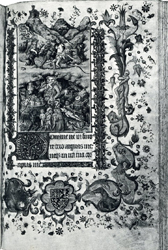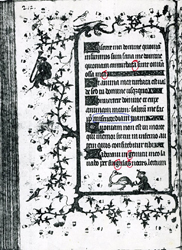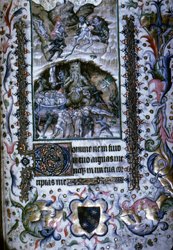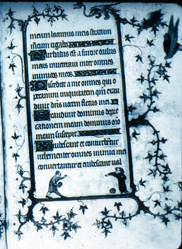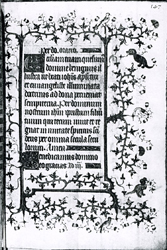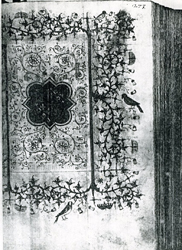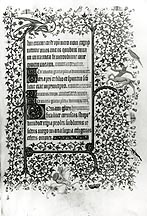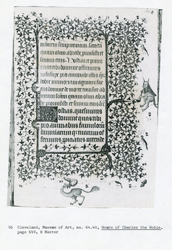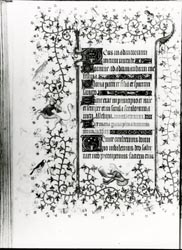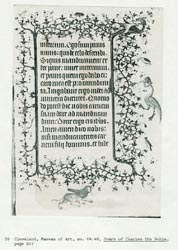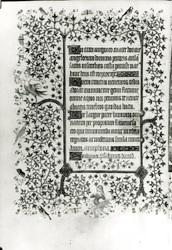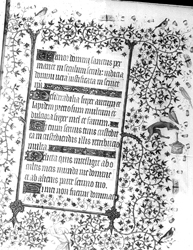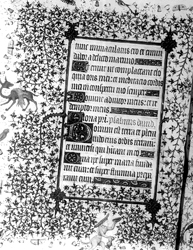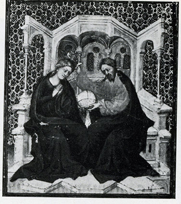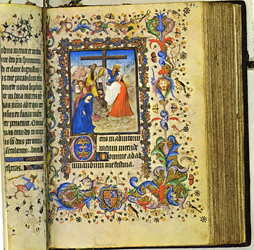Comparison of the Hours of Charles the Noble to Douce 62
p. 211: Penetential Psalms from the Hours of Charles the Noble. While the border decoration of the miniature pages by the Master of the Brussels Initials in both Douce 62 and the Hours of Charles the Noble are very similar, a difference is the inclusion in the bottom corner acanthus decoration in Douce 62 of a dog and another animal. P. 211 is the only instance of these animals appearing in miniature borders in the Hours of Charles the Noble. A difference between these animals in the Hours of Charles the Noble and in Douce 62 is the coloration of the animals. The dog is consistently white in Douce 62. In the Hours of Charles the Noble the dog is brown. This suggests that it was between the stages of designing and painting the border the confusion occurred. |
Hours of Charles the Noble, p. 212: the decorative plan of this page is not consistent with the plan of the book as a whole. This page has a bar staff around three sides of the page while the plan of the Hours of Charles the Noble called for a bar staff in the outside border of each page. Also the gold ground foliate decoration of this page is in contrast to the dentelle decoration found typically in the Hours of Charles the Noble. The decorator of this page appears to be the same hand who decorated in the inner bifolios of the gathering containing the Penetential Psalms in Douce 62. Compare to folio 96 of Douce 62. The decorative plan of this page from the Hours of Charles the Noble is consistent with the plan of Douce 62. Notice how the positioning of the drolleries in the bas de page is consistent with the layout of Douce 62. The text of p. 212 of the Hours of Charles the Noble ends at the same word ("lectum") as folio 95v of Douce 62. It therefore seems likely that the original, outside bifolio of the Penetential Psalms in Douce 62 was mistakenly bound in the Hours of Charles the Noble. The current outside bifolio of Douce 62 was done as a replacement by a different decorator, here identified as the Cleres femmes F Decorator. |
|||
f. 95v: Cleres femmes F Decorator. |
||||
| The decorator of f. 95v and its conjugate is different from the rest of the gathering. The decorative plan of this bifolio is consistent with the remainder of Douce 62 except that there is no bas-de-page illustration. The drolleries were done by the Master of the Brussels, and not the craftsman responsible for the leaves in the gathering. It is evident that this bifolio is a replacement for the original bifolio that was mistakenly included in the Hours of Charles the Noble. This confusion would have occurred during the stage of the painting the miniatures. | ||||
Hours of Charles the Noble, p. 147. The page was decorated by the Cleres femmes F Decorator who was also responsible for f. 95v of Douce 62. The decorative plan of this page with the bar staff around three sides of the page is consistent with Douce 62 and not with the general decorative plan of the Hours of Charles the Noble. |
Hours of Charles the Noble, p. 273. Responsibility of the Cleres femmes F Decorator. |
|||
Add. 29433, f. 20v: decoration attributed to Petrus Gilberti. This same decorator is responsible for the calendar in Add. 29433. |
Hours of Charles the Noble, p. 657: decoration attributed to Petrus Gilberti. |
|||
| The bifolio formed by folios 22 and 25 in Add. 29433 is particularly interesting since three different decorators collaborated on this single bifolio. As noted above folio 22r can be attributed to the B Master of the Belles Heures, while folio 22v and its corresponding face at the other end of the gathering folio 25r recto can be attributed to the A Master of the Belles Heures. Folio 25v is clearly by a different decorator who can perhaps be identified as the decorator responsible for at least part of the first gathering of the Office of the Passion in the Belles Heures. To have three different decorators collaborate on a single bifolio and to have all three of these decorators be involved apparently concurrently in the decoration of such a major commission as the Belles Heures is extraordinary. | ||||
Add. 29433, f. 83: Coronation of the Virgin. The miniature is attributed by Meiss to a French Master, but it is evident that the majority of the miniature is by the Master of the Brussels Initials while the head of Christ is by the Egerton Master. This provides another link in the making of Add 29433 and the Hours of Charles the Noble, since the Egerton Master painted miniatures in the Cleveland manuscripts |
||||
